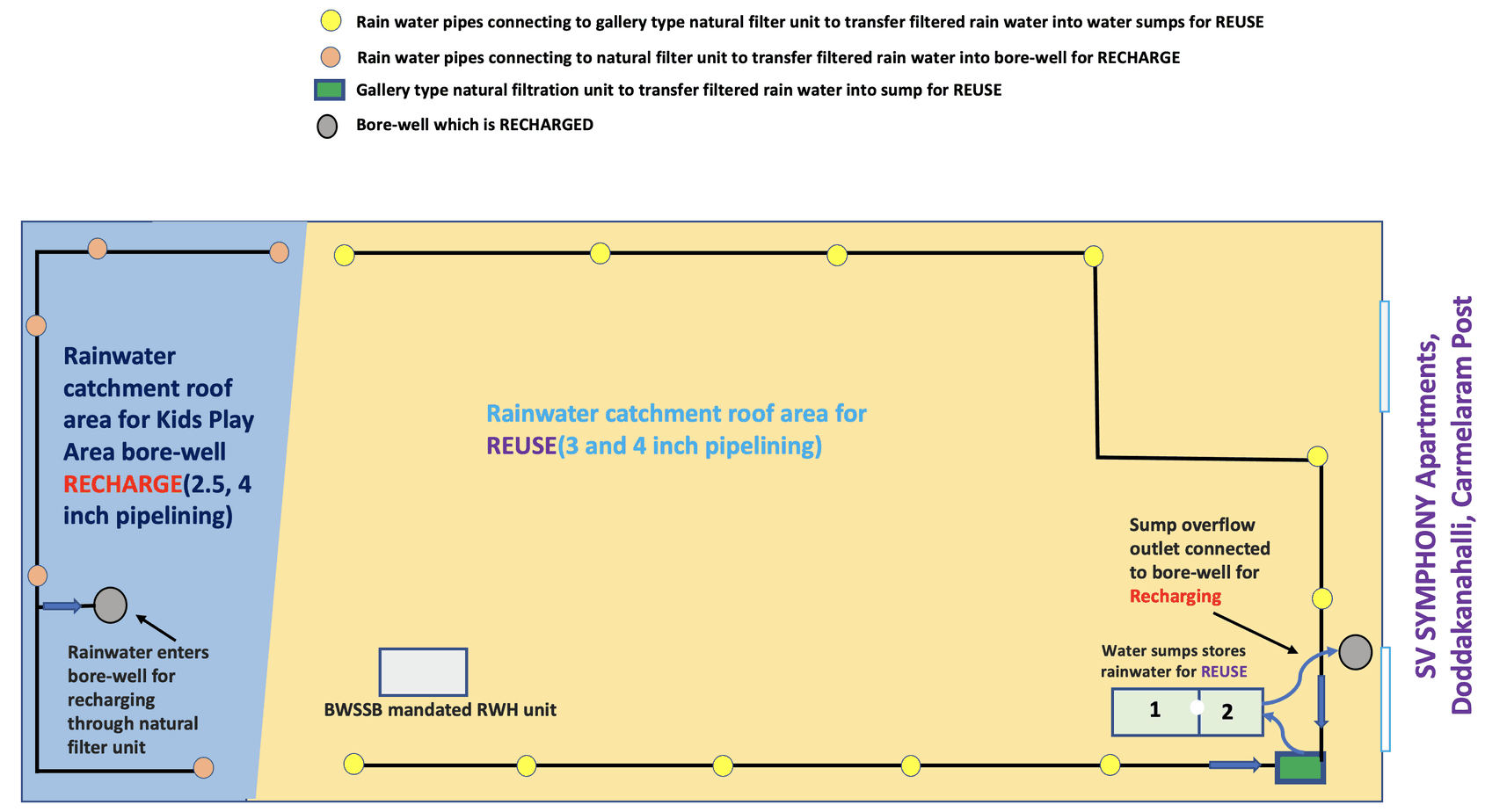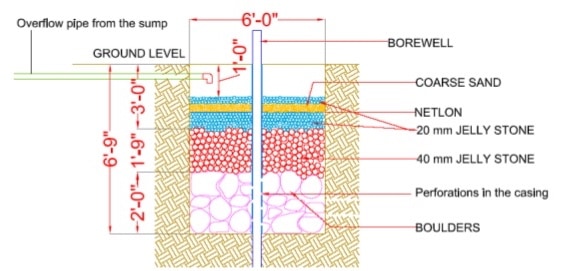“You ain’t gonna miss your water until your well runs dry”: Bob Marley
Why did Indo-Aryans move towards Indus Valley and then to the Ganges Plain? Why did Dravidians settle near rivers? There may be several reasons.
But, with the water crisis we are facing, I think we now know the answer – water. Civilisations flourished where water was available. The clock is ticking, and we need to do what is vital for our survival – save water.
According to news reports, our city may turn uninhabitable in the next few years due to rapidly-depleting groundwater levels. Rainwater harvesting (RWH) is the best technique to revive groundwater levels quickly, reduce wastage, and save money. But traditional groundwater recharge pits may not work in all cases and in all parts of the city. A better option would be to store and use some of the rainwater that’s captured, and to use the remaining water to recharge borewells directly.
In Bengaluru, excess borewell digging and groundwater exploitation have caused a large number of borwells to dry up. Many of us opt to leave these borewells dry, but these can instead be used to recharge groundwater. Gradually, the borewell may start meeting your water requirement too.
How we set up our RWH system
Let’s see how we at SV Symphony – a small community of 52 flats in Chikkabellandur, off Sarjapur road – implemented our rooftop RWH and borewell recharge project. Our locality does not get Cauvery water supply. Apartments here rely entirely on borewells and private tankers for water. Some large apartments even buy 50 tankers of water per day during the summer.
But with rainwater harvesting (RWH), our apartment community has minimised tanker use. In the last four-and-half years, we have used 14 million litres of filtered rainwater directly, which translates to average savings of over Rs 3 lakh per year. Additionally, with direct recharge, our two borewells yield continuously and never dry up.
We started our project in March 2015, after consulting Ayyappa Masagi, known as the ‘Water Warrior of India’ or ‘Water Gandhi’. Masagi has worked extensively on rainwater harvesting, and has helped people across India fight water scarcity. We entrusted Masagi’s organisation Water Literacy Foundation with our project.
What really got the project going was our community’s enthusiasm. We didn’t want to wait and waste precious rainwater, so we made this project operational even before the builder handed over the apartment to us.
Rooftop water sent to two sumps and two borewells
To set up the system, we segmented the rooftop of our apartment complex into two – one section with catchment area of 15500 sq ft, and another of 1440 sq ft. Both sections already had conveyance pipes to collect rainwater.
Our vendor installed a common conveyance to collect the runoff from the 15500 sq ft section, and to channelise it into a filtration unit. After filtration, the water is sent to two sumps located in the parking area of the complex, for storage. The sumps have capacity of 16,000 litres each.

Layout of the RWH unit. Rainwater falling on one part of the rooftop (highlighted in yellow), is sent to sumps and a borewell after filtration. Water from the smaller rooftop, highlighted in blue, is used exclusively for borewell recharge.
The stored water from the sumps is pumped up to a 12,000 litre overhead tank, and used directly. Excess water from the sumps is sent to a borewell nearby, for recharge. That is, water falling on the 15500 sq ft section of the rooftop is both used directly and sent underground for recharge.
But rainwater falling on the other section of the rooftop, of 1440 sq ft area, is used exclusively to recharge another borewell, and not for storage/direct use. Here too, conveyance pipes first carry the water to a filtration unit, and then to the borewell.

Filtration unit during and after construction. Rooftop rainwater is filtered using this unit, and then sent to sumps or borewells. Pic credit: WLF
How is the borewell recharge system set up?
For direct borewell recharge, quality of the water sent underground is extremely important. In addition to the filter overground, a natural filtration system would be set up around the borewell casing pipe too. This natural filtration system comprises sand, rocks and boulders.
Water coming from the rooftop and through the filter, is channelised into this natural filtration system. Here, water seeps down through the layers of sand and rocks and get purified further. At a certain depth, holes would be made on the borewell casing. Filtered water then enters the borewell through these holes.

Illustration of a direct borewell recharge system. Credit: bengaluru.urbanwaters.in
A proper filtration system reduces the risk of silting and air locks in the borewell. If the water is unfiltered, soil could block the holes around the casing pipe.
The natural filtration system is also designed to absorb the heaviest rainfall intensity in Bengaluru, which is 90 mm/hour. This ensures that even severe rains would not lead to overflow from the borewell.

(Left) Holes on the borewell casing pipe. (Right) Filtered rainwater from the apartment comes from the PVC pipe in the upper right corner, and falls into the natural filtration system around the borewell casing pipe. Pic: WLF
Precautions
We have put up strict guidelines to avoid contamination of the rooftop:
DON’Ts
DO’s
|
Rs 3 lakh savings per year, plus water security!
Overall, we have spent Rs 1.6 lakh for this project, but the returns have been way higher. In the last four-and-half years, we have stored and directly used over 14 million litres of rainwater. This would be the equivalent of 2400 tankers of 6000 litre capacity each – that is, tankers we’d have had to buy if we didn’t have the RWH system.
By not buying these 2400 tankers, we have saved around Rs 14 lakh so far, which comes to over Rs 3 lakh every year.
In addition to these direct savings, we also save because of continuous water yield from our two borewells. We have sent 14 million litres of water into the ground through borewell recharge so far.
We still end up buying around 50 tankers of water a year, much of these in June when water scarcity is severe. However, our tanker use is much lower than that of neighbouring apartments. To reduce our use of tankers further, we are planning to build more overhead sumps that would enable us to store more water during severe rains.
Apart from the RWH system, we have a well-maintained Sewage Treatment Plant (STP) which provides treated water for toilet flush tanks, saving a lot of water. The treated STP water was tested in a lab to make sure it can be reused and doesn’t have bad odour or harmful materials.
We also added water-saving aerators to our taps, to reduce water wastage. A few years back, we as a community also agreed to close our swimming pool, so that we could save a lot of precious water.
We have shared our story on different platforms, which encouraged people to implement similar water-saving techniques in their homes and apartments.
Groundwater is a common resource, and all apartment complexes draw it through borewells. Though our apartment sends large quantities of rainwater underground, it can contribute only so much to improve groundwater levels in the locality. If more apartments replicate our RWH initiative, we can drastically increase groundwater levels in the area and ensure water security for all!
Additional resources
List of engineers, plumbers and contractors trained in RWH
[Samir Kumar Rakshit can be reached at samir.78p@gmail.com or at rakshitmca on Twitter]
An excellent initiative and a most positive community. I am not sure if the Association is a member of Bangalore Apartment Federation (BAF). If yes please share your write up with them so that communities can give focused attention. If not a member, please become one so that we can share more information that would benefit the entire community of flat owner s/dwellers. As the Community have shared their success which is of medium term,I am sure it will remove genuine doubts of many. I wish them continuous success in all their initiatives.
Thank you, sir, for your nice words! We are not part of BAF but would contact them!
It is very important to remove all potted plants from roof top from which water is collected for rain water harvesting. Compost and other fertilisers are added to the soil while repotting.The water flowing out of the potted plants are highly infectious and dangerous if used for RWH.
Hello there, we don’t have any potted plants in the roof top.
‘@Samir, do you provide consultancy as well ? How can we reach out to you
Hello Bhagya, I do guide people in RWH for Recharge&Reuse as a volunteer(free of cost)! You can reach out to me over Twitter @rakshitmca or to my Gmail id:samir.78p@gmail.com! Thank for reaching!
I am proud to have designed and implemented this project. It was nice coordinating with Mr. Samir and Mr. Marasami from the apartment welfare association. Very glad to see the results. God bless you sir.
Thank you so much Praveen! You did a great job!
People need to be passionate about water like you to deliver good projects like this!
Regards
-Samir